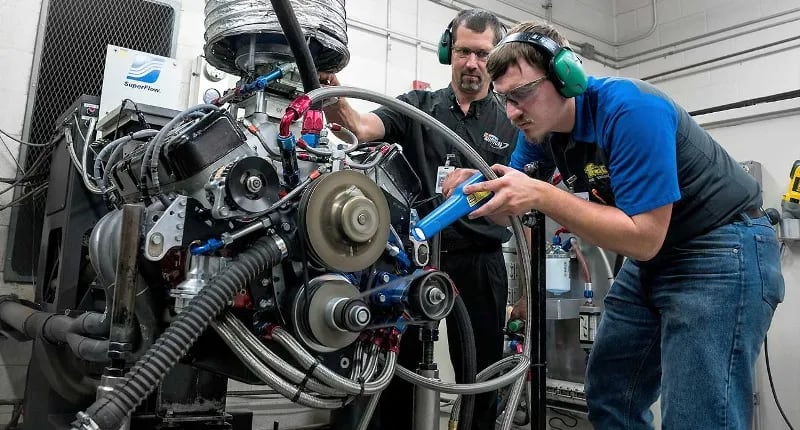Answers to 11 Commonly Asked Questions About NASCAR Tech
Considering enrolling at NASCAR Technical Institute? Click here to find answers to 11 commonly asked questions about the school.
Since its formation in 1948, NASCAR has been a leading producer and promoter of stock car races. People love watching cars modified with the latest technology competing in tests of speed and handling.
One of the main areas modified in NASCAR vehicles are the engines. Unlike standard car engines, NASCAR engines must produce large amounts of power for hours on end and remain durable with no room for failure.
Students at NASCAR Technical Institute in Mooresville, North Carolina, get to work on these components firsthand in the NASCAR Technician Training program. The 15-week specialized training course covers these high-performance engines.
Keep reading to find out more about how these engines work and about training opportunities at NASCAR Tech.
NASCAR horsepower is high. Like, really high. Vehicles competing on the track have engines that can produce upward of 750 horsepower, while the average car on the road is typically going to fall in the range of 180 to 200 horsepower.
Horsepower translates to speed on the track, so it makes sense for NASCAR engines to be well equipped. This high horsepower is possible because these engines are custom made and built with precise parts. All the engine parts, from the pistons to the valves, are weighed and sized so things are as balanced as possible.
The cam profiles on NASCAR engines also allow for intake valves to open sooner and stay open longer than passenger vehicles. The purpose of this is to bring more air to the cylinders, particularly at high speeds. The engines are assembled and then go through a series of tests and inspections to ensure they are race ready. This involves the vehicle running on a dynamometer to measure the engine’s maximum power output.
After an initial inspection, the vehicle then runs on the dyno for another two hours, and ignition timing is adjusted to maximize power while the engine runs through a range of power cycles and speeds.
It’s safe to say building an engine for the track is a meticulous and detailed process. Other components also contribute to a NASCAR vehicle’s performance on the road.
There are many parts on a racing vehicle apart from the engine that are built differently than a standard car. A NASCAR chassis, or frame, is built with extra safety specifications, like a roll cage, to help prevent injury to the driver in the event of an accident.
Both the exhaust and transmission systems in these vehicles also have different features than your standard passenger car. These systems play a role in helping NASCAR engines run smoother and with more power.
Exhaust systems contain many parts, from the manifold to the catalytic converter to the muffler. They help to expel fumes generated as a vehicle runs.
NASCAR exhaust systems are specifically built to improve engine performance. The quicker fumes can be expelled, the more oxygen an engine can receive and the quicker it can generate additional power.
Performance exhaust systems used in stock car racing allow for a more efficient path for these gases to exit the combustion chambers, allowing for more fuel and air to burn. These exhaust systems can even affect the horsepower of the engine.
The transmission helps deliver power from the engine to the wheels of a vehicle. There are both automatic and manual transmission options in most passenger vehicles. However, NASCAR transmissions are all four-speed manual.
In a passenger car, the manual transmission requires the drive to depress a clutch pedal to switch gears. While NASCAR vehicles have clutch pedals, they are rarely used. Instead, NASCAR drivers shift gears using rev matching, a process that requires the driver to match the car’s speed to its RPMs.
NASCAR transmissions have straight-cut gears, which are essential for racing vehicles. This is because they both increase torque (an engine’s rotational force) and produce no axle load.
NASCAR Tech is the exclusive educational provider for NASCAR. It’s also the only campus in the country offering NASCAR-endorsed training — a pretty big deal for those who see themselves working in motorsports.24

The 15-week NASCAR Technician Training program teaches students the fundamentals they need, from working on high-performing engines to learning about fabrication, welding, aerodynamics and pit crew essentials. Students are eligible to enroll in the specialized training course once they have completed the core automotive program training.
Courses covered over the 15 weeks include:
To qualify for the NASCAR specialized training program, you’ll need to complete one of the following:
Additional admissions requirements can be found here, and you can always speak with an Admissions Representative to get your questions answered.
Developed by NASCAR, the spec engine course is an exclusive program that gives a select number of students the chance to go to the lab and build engines that compete in the ARCA Menards Series East, a regional stock racing series.
Only a small number of students can be selected to participate in the in the three-week spec engine course. For students to qualify, they must maintain a minimum 3.8 GPA and a 98% professionalism and attendance score. These requirements help keep class sizes small, maximizing the individualized training for students when they work on the engines.
You can get hands-on industry experience for the world of motorsports when you attend NASCAR Technical Institute in Mooresville, North Carolina. NASCAR Tech is the only campus in the country offering NASCAR-endorsed training.
Find out more about the program and admissions requirements by requesting information here. You can also call 1-800-834-7308.
Universal Technical Institute of Illinois, Inc. is approved by the Division of Private Business and Vocational Schools of the Illinois Board of Higher Education.